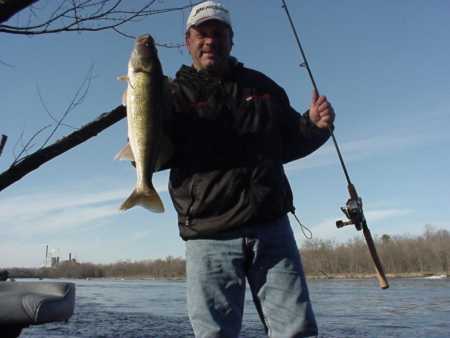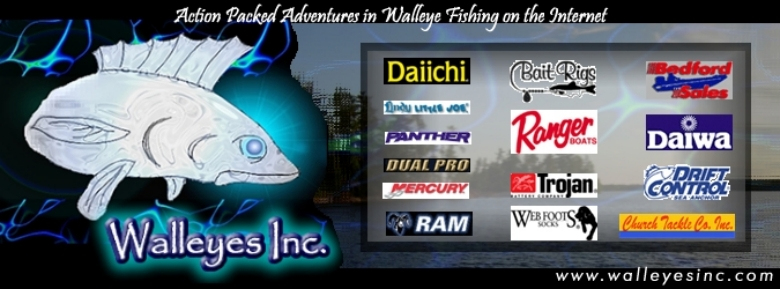|
Beauty, as the saying goes, is in the eye of the beholder.
However, one thing we can all agree upon is that there are
few things more alluring than a 30-inch walleye coming to
the net. As anglers, we have an interpretation of a "perfect
10" that is all our own. We also have more tactics to
make that beautiful moment happen than ever, and if you spend
enough time on the water, you will see some combinations and
concoctions being employed today that will raise at least
one eyebrow. It's ingenuity at its best, and it's one reason
today's anglers are catching more and bigger fish than ever.
While techniques mastered by our sport's forefathers are still
as good as walleye gold, inquiring minds have taken those
traditional methods and revised them to meet almost any need.
Some of this revolution is driven by necessity. Anglers are
better-educated and better-equipped than ever. That means
more people catching more fish. There is more competition
for those fish, which also happen to be better-educated because
of the additional pressure they experience today. Manufacturers
are always on the cutting edge. Who would have guessed
20 years ago that MinnKota would develop its line of Engine
Mount electric trolling motors that mounts to the shaft of
an outboard to provide the ultimate in stealth? Instead of
running the Mercury kicker on my Triton 215X in shallow water
and sending planer boards out hundreds of feet, I can now
prowl the shallows in relative quiet and keep my boards closer
to the boat where there is less margin for error. Who could
have foreseen the complex technology Lowrance is now able
to offer in many of its sonar and GPS units. The 111HD, for
example, is a combination GPS and sonar unit with incredible
detail and a broad range of detailed maps already on the unit's
hard drive. It's a far cry from the old "Green Box."
As for the anglers themselves, a few years ago, it was common
knowledge that you couldn't catch walleyes on crankbaits or
nightcrawlers in cold water. Now we do it regularly. Bottom
bouncers used to be the tool of choice for fishing deep water
and steep contour. Now we have in-line weights and snap weights.
The old "book" said you couldn't troll spinner rigs
at 2 mph, and you couldn't mix cranks and spinners in the
same trolling spread.
 |
That book has been shelved as today's anglers write
new chapter after new chapter. Some are willing to try
almost anything, and they are discovering ways to catch
walleyes previous anglers never considered. Who's to say
what will work and what won't work without any first-hand
knowledge or experience? It's all about keeping an open
mind.
Many of today's top tricks are based on the philosophy
that more is better. Give the fish a variety of things
to consider and the likelihood that they will see something
they like increases |
Double spinner rigs are catching on, especially for open-water
fish that rely more on sight and sound than scent to feed.
The idea is to give them a bigger target with more flash that
they can see from a considerable distance in clear water environments.
Double spinners even give the illusion of multiple baitfish
in the water. Crankbait-spinner combinations are catching
on, too, in open-water situations. The crankbait serves as
an attractor with its wobble and flash while the spinner rig
offers an entirely different look. You can run these
rigs one of two ways, depending on state laws regarding the
number of lures that can be used on one line. In states where
multiple lures are legal, use a three-way swivel and attach
a deep-diving crankbait like a Storm Hot 'n Tot to a three-foot
lead with a spinner rig trailing from the other eye of the
three-way. In states where only one lure may be used per rod,
take the hooks off the crankbait and tie it in-line with the
spinner tied to the rear eyelet of the crankbait. Some anglers,
mostly on river systems, have discovered the value of running
two stickbaits in-line. Floating Rapalas and shallow running
Storm Thundersticks are good choices. Tie one to your line
as you would normally, then run a three-foot lead off the
back eye of the Rapala to another. The setup takes most of
the action out of the lead Rapala, but that's often the one
neutral or cold-water walleyes hit. Jig-and-crankbait or jig-and-spinner
combinations are another effective option. River anglers and
structure fishermen both like this presentation. Use a heavy
Lindy Jumbo Jig tipped with big plastic or live bait as a
dropper and trail it with a Floating Rapala or a spinner rig.
These rigs can be deadly when worked along the face of a wingdam
or along the edge of a rockpile. Once you start thinking with
an open mind, there is no end to the possibilities.
You can use Erie Dearies without the hooks or specifically
designed fish attractors as in-line weights. You can "Dubuque
rig" by running a leader with a crankbait on one end
and a swivel on the other up the main line, then tying another
swivel to the end of the line. A heavy jig on a short lead
is added to the main-line swivel to complete the rig. You
can run spinner rigs over the tops of weeds by using no weight
or a small, in-line bullet weight. You can change depths in
the water column quickly by employing snap weights. You can
"pole line," which is a variation of hand-lining
where a heavy weight keeps the main line vertical while leaders
of varying length are attached at predetermined locations
on the main line. In situations where anglers are limited
to two rods but may use three lures, you can accomplish this
goal by using a three-way rig behind an Off-Shore planer board.
Let it halfway out, then attach the third line to the line
coming from the rod. The only problem with that approach is
that you must hand-line the extra lure into the boat before
you can detach the board and attempt to land the fish, which
adds to the margin for error. Give it some thought. Chances
are there is something you can try that will address whatever
situation you are facing on the water. Some anglers laugh
at these innovations and call fishing with them "dragging
junk." I just call it a thing of beauty.
|

